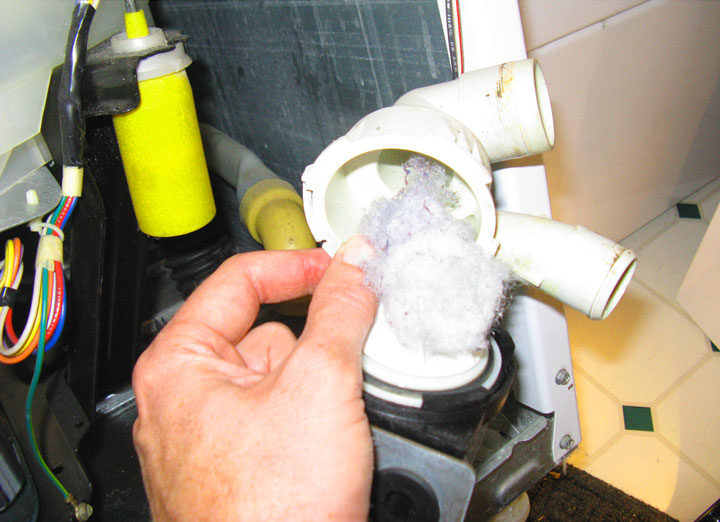 The washing machine is an essential household appliance in the house of every housewife and caring mother. But it often happens that during the operation of this home helper, there can be interruptions with the work, due to which as a consequence the drain system is clogged.
The washing machine is an essential household appliance in the house of every housewife and caring mother. But it often happens that during the operation of this home helper, there can be interruptions with the work, due to which as a consequence the drain system is clogged.
How to clean the drain in the washing machine at home, and how in the future to prevent the appearance of this problem we will tell in more detail in our article.
Types of clogs and their causes
Experts at the service centers to repair the drain of the washing machine distinguish two types of clogsNormal and mechanical.
Mechanical .
The main reason for the formation of clogs of the mechanical type is the ingress of foreign objects into the filtering system of the structure.
Most often, the role of such "cloggers" is played by:
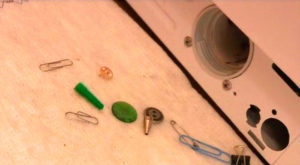 Money coins and small buttons.
Money coins and small buttons.- Locks from clothing.
- Clasps and bra bones.
- Toothpicks, tissues, small toys.
- Money and other contents of pockets.
When foreign objects get into the filtration system, the drain system locks up and the washer simply stops working.
Normal
Apart from the ingress of foreign clogs, the washing machine drain system can also clog in another way, naturally.
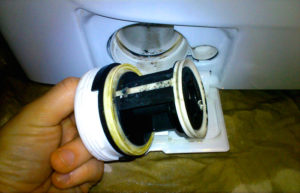 This is often due to the accumulation on the filter of all kinds of lint, fluff, and bits of absorbent cotton that were on the machine.
This is often due to the accumulation on the filter of all kinds of lint, fluff, and bits of absorbent cotton that were on the machine.
The hair of your pets also stays on all items, and primarily on the machine. And with a new wash cycle of your bedding set, clothes, or anything else with the drains, the hair also gets into the drain hose, where it stays, and after a certain amount of time, it gets clogged permanently in the filter.
Blockage of the washing machine drain system can be identified by a number of obvious signs:
 Reduced drainage speed Used liquid (contaminated water).
Reduced drainage speed Used liquid (contaminated water).- Appearance of a program failure, when the washing machine does not switch to the rinse or spin mode by itself.
- Total blockage of the machine operation.
If your washing machine still has its unexpired warranty period, you can repair it without any problems, without any financial investment. But if the problem appeared after several years of use, you should try to clean the system yourself. Such a simple operation to remove a clog in the washing machine can be done by yourself in half an hour.
Peculiarities of the drain system of a constructive nature
Before you start fixing this kind of problems, you should in theory understand the the structure of the drainage system washing machine. In the design of the new models, the used liquid from the drum is transferred to a special connection.
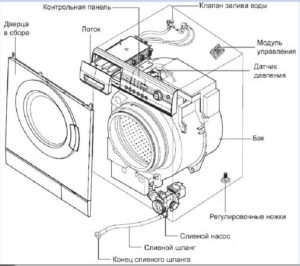 The outlet pipe is connected to a purification filter, on which all dirt and small impurities that come with water from the drum is deposited. The used water, after passing through the connection and the filter, enters the pump. And in it, under the action of pressure, which appears as a result of the constant rotation of the impeller, it flows through a hose into the sewer.
The outlet pipe is connected to a purification filter, on which all dirt and small impurities that come with water from the drum is deposited. The used water, after passing through the connection and the filter, enters the pump. And in it, under the action of pressure, which appears as a result of the constant rotation of the impeller, it flows through a hose into the sewer.
The outlet channel of the drain hose is connected either to a nearby siphon or to the sewage system itself. Some people have made it easy for themselves by not connecting the hose to the sewer system, but simply dropping its end into the bathtub or sink.
But a clog is a tricky problem, and it can occur in any part of the drainage system. But what makes it easier to remove a clog in the washing machine is that most often the clogs are exactly in the area of the cleaning filter.
How to clean the drain hose with your own hands
Cleaning the filter
The filter system is located at the bottom of the washing machine, on the right, behind a small door with a hatch. To open it, you need to pry the edge of this hatch with your fingers or some flat blunt object.In some models, the panel can be opened by pressing the latch or by unbending the swivel hooks.
To clean the filter, proceed as follows:
- Unscrew the screw and carefully remove the filter.
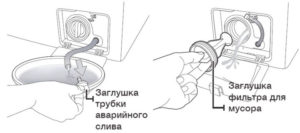
- Tilt our construction, pour out all the liquid, setting in advance for this purpose a container with low rims.
- After there is no water left in the machine, take out all the foreign objects stuck. If the elements of the structure are completely covered with limescale, they must be completely replaced.
- Next, when you have already eliminated contamination by rinsing with water and wiping with a damp sponge, inspect the place where the filtration system is located, and remove any remaining contamination from the walls.
- Clean the the pump and the surrounding system, and then connect your unit to power and turn on the drain mode. If you have done everything correctly, the blades and impeller of the pump system will rotate without interruption.
All the details can be found in the detailed video overview.
Disassembling the drain pipe
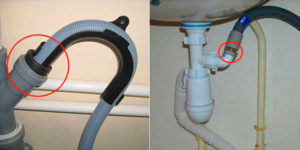 It is also possible that the drain of the liquid will simply be blocked even just in the places of connection with the sewage pipes. To clean the drain in this case you need to disconnect the hose.
It is also possible that the drain of the liquid will simply be blocked even just in the places of connection with the sewage pipes. To clean the drain in this case you need to disconnect the hose.
Everything is carried out in several stages:
- Disconnect the washing machine from the power supply.
- Shut off the water supply valve.
- Using a flat screwdriver, remove the side or front bottom panel.
- Pour the remaining used water out through the drain filter.
- Using pliers, disconnect the end of the hose from the sewage pipe or trap.
In devices of such brands as VEKO, Ariston, Candy, Samsung and Indesit can reach the drain hose only through the bottom. In such cases, for the convenience of cleaning the washing machine from clogs, put your machine on its side, laying some kind of cloth under it in advance. After you unfasten the clamp with pliers, you can safely disconnect the hose from the pump.
In washing machines by Electrolux or Zanussi, the hose runs along the back wall. In order to get to it, remove the back cover. Next, unclench the latches, detach the drain hose, and then unscrew from the hose for water supply. To remove the drain hose completely, you have to completely remove the top cover by unscrewing all the screws and loosening the clamp to lock it in place.
In machines such as Bosch and Siemens, you can get the hose by removing the front panel of the housing. Everything is done in the following order:
- Remove the sealing rubber from the front panel and unfasten the clamp.
- Take out the bottom panel and the sliding tray for detergents.
- Unscrew the locking bolts and remove the hatch door lock.
- Remove the front panel of the housing.
- Loosen the clamp and pull out our hose.
Cleaning the washing machine drain hose
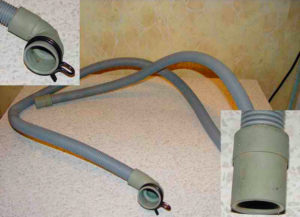 Clean the drain hose by rinsing and working the walls on the inside with the use of special scrubbers. Masters in this case are used to use not metal brushes, but those made of synthetic.
Clean the drain hose by rinsing and working the walls on the inside with the use of special scrubbers. Masters in this case are used to use not metal brushes, but those made of synthetic.
To clean the walls from the inside, a rope is inserted into the dirty hose and moves it back and forth. After this procedure, you need to rinse the hose with water. If the contamination could not be removed the first time, the procedure should be repeated.
The hose, flushed from all sides, only needs to be fixed in its old place, following all the steps described in reverse order.
Preventing clogs
In order to avoid the occurrence of the same problem in the future, perform a number of certain actions:
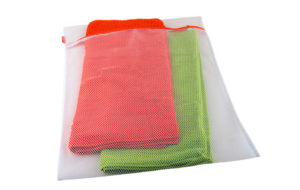 Always check all pockets before washing.
Always check all pockets before washing.- Use special garment covers for laundry.
- If your clothes have buttons and locks, fasten them before loading them in the machine.
- Add extra detergent along with the detergent. additional detergent to soften the water.
To give yourself extra protection against machine clogs, put an extra filter on the inlet pipe when using the machine.
Professionals recommend that every two or three months, you should have clog prevention. To do this, you should periodically inspect your system, check the filters and remove mini clogs that have already appeared.




